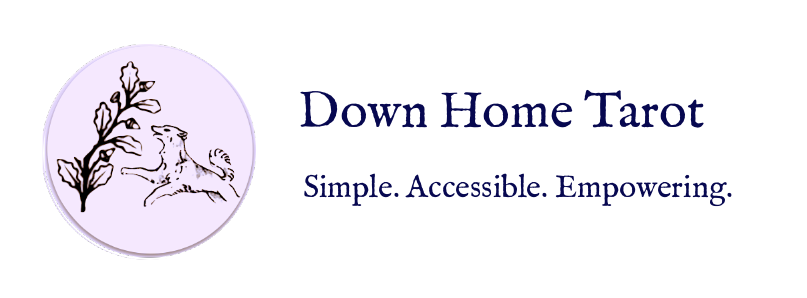The cards are a bit bigger than playing cards, but much smaller than my Universal Waite-Smith; the Shadowscapes deck is actually the perfect size for my hands. The backs are reversible (in case you want to read reversals), featuring a lovely circular design evocative of carved stone, seemingly illuminated by stars. The cardstock quality is firm but with enough give for easy shuffling. Pui-Mun Law has associated each suit with an animal, a device I always love. Wands are foxes, providing the suit with a clever, fiery energy. The fish and aquatic creatures in the suit of cups conveys the watery world of love and emotion. The swans, with their aloof nature, are a perfect fit for the airy suit of swords. Finally, in an interesting twist, pentacles are accompanied by lizards and dragons of varying shapes and sizes (traditionally, salamanders and lizards are historically associated with fire, and thus the suit of wands).
Below, I have a selection of cards that I pulled for a deck interview spread (I took this one from Little Red Tarot, who credits TABI). I learned a lot about the deck and its uses through this exercise!
********************
What is your most important characteristic?
This card is a great example of the swirling energy present throughout the deck. The Knight of Cups has confidence in the compass provided by his emotional reality. He sees beauty and love everywhere. This deck believes in the validity of dreams, and in celebrating that which is true and beautiful.
What are your strengths?
I quite like this take on the Eight of Swords. While the large, frantic swan is trapped amidst the thorns, the tiny, nimble hummingbird can navigate them with little danger. This deck shines as a source of calm when facing a crisis or stressful situation.
What are your limits?
Pui-Mun Law's Temperance features a turbulent balance between yellow and blue, warm and cool, light and shade. The meaning of this trump card--balance and cooperation--is very apparent in the illustration. As a limitation, this deck may not always provide a balanced view. It will be a good source of assurance and comfort, but probably not the deck to go to if I need a harsh wake-up call.
What are you here to teach me?
What a delightful card to pull! The Magician calls on all the elements in balanced measure, as represented by the hanging adornments fastened to his wings (each represents a classical element, and thus, a suit). This deck will be a good source of strength and motivation towards manifesting my goals.
How can I best learn and collaborate with you?
This card is really breathtaking. The swirling energy so common in Pui-Mun Law's art is evocative of the nautilus, a perfect crown for this King of Cups. The ropey texture of the kelp gives this card a unique feel, and the dignified turtles give a special weight to the king in a suit mostly characterized by small, whimsical fish. I especially like this card as an echo to the earlier Knight of Cups. I am reminded to approach this deck with patience, and expect and accept from it compassion.
What is the potential outcome of our working relationship?
The Two of Swords can represent an impasse or stalemate (when teaching myself card meanings, my mnemonic for this card was "between a rock and a hard place.") I have since learned that the card can also be read as tranquility and acceptance for the pauses in our lives. This deck, then, is not here to get me all the way to my goals and tell me everything I need to know; instead, this deck will help me find tranquility when I feel stuck.
********************
It looks like my relationship with the Shadowscapes Tarot will be less about finding balanced, complicated truths, and more about reconnecting with my most authentic emotional self. I can think of no better guide than Pui-Mun Law's delicate, luminous art.
Is this a deck you could see yourself using? Is this the first time you've seen it? Let us know!














